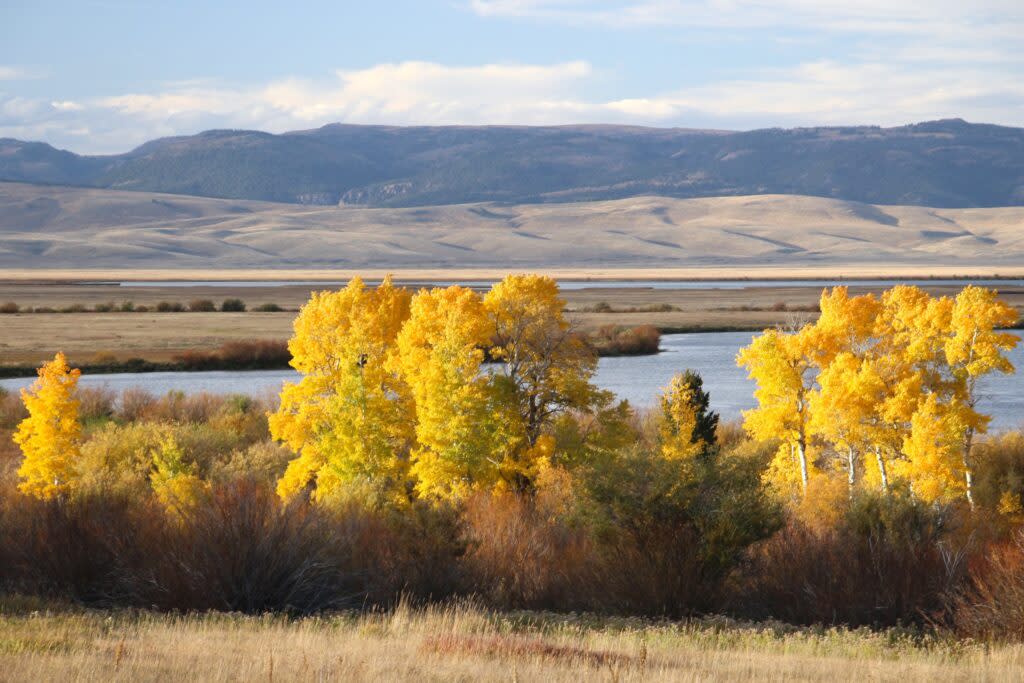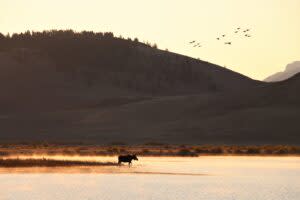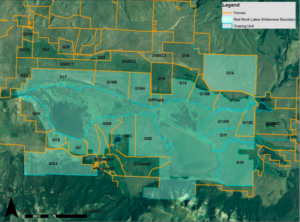Groups sue over grazing agreements in Red Rock Lakes National Wildlife Refuge

Mature aspen trees with leaves in full autumn gold color shimmer in the wind next to Upper Red Rock Lake at Red Rock Lakes National Wildlife Refuge. Photo by Cortez Rohr/USFWS.
Two conservation groups from Montana and Idaho sued the U.S. Fish and Wildlife Service this week over commercial grazing agreements in Red Rock Lakes National Wildlife Refuge that were renewed last year but which the groups say rely on an environmental analysis from 1994 in violation of federal law.
WildEarth Guardians and Western Watersheds Project filed the lawsuit Tuesday in the U.S. District Court of Montana. The suit claims the Fish and Wildlife Service violated the National Environmental Policy Act, Administrative Procedure Act and the Refuge Act by not preparing an updated environmental impact statement and other analyses when granting new cooperative agricultural agreements and commercial special use permits allowing five ranchers to graze their livestock within the refuge through October 2027.
“Red Rock Lakes National Wildlife Refuge is a vital part of the largest nearly intact ecosystem in the Lower 48, and for decades the Fish and Wildlife Service has promised to keep close tabs on grazing there to safeguard its wildlife from harm,” said WildEarth Guardians Public Lands Attorney Chris Krupp. “Unfortunately, it’s done no such thing. Instead, it’s repeatedly rubber-stamped grazing permits, with no genuine monitoring or evaluation of the impacts of its program.”
The 83,000-acre wildlife refuge, which sits in the Centennial Valley between Lima and West Yellowstone and is part of the Greater Yellowstone Ecosystem, was established in 1935 and is managed primarily for wildlife and ecological conservation and rehabilitation, according to the Fish and Wildlife Service.
It is home to grizzly bears, many migratory birds, wolves, elk, pronghorn, sage grouse and one of the last native populations of Arctic grayling in the U.S. that spawn in tributary streams before maturing in nearby lakes.
Certain amounts of livestock grazing were allowed in the refuge since its inception, but the USFWS in the 1960s found it conflicted with the purpose of the refuge and scaled it back. In 1994, the service did a new environmental impact study that looked at alternatives to grazing, and allowed the practice to continue at low levels as long as the service could monitor, study and adapt the program.
There are 26 grazing sub-units authorized in the refuge that include wet meadow, grassland and shrub-steppe environments that cover about 28,000 acres, and grazing typically occurs between mid-summer and October.
The 1994 environmental assessment found that though grazing had been “substantially reduced” from historical levels, long-term grazing would not allow for the refuge to meet its purposes of wildlife and ecological conservation because of livestock impacts to streams and wetlands. But the Fish and Wildlife Service decided to move forward with a plan that allows for grazing but under scrutiny of the service.
“To implement adaptive management, prescriptions will be written before habitats are treated with a management tool,” USFWS wrote at the time. “Monitoring will be more structured as part of this prescription. The process will require Refuge staff to plan, monitor, analyze, adjust, and replan for the following year, rather than rely on a pre-determined rest-rotation schedule.”
The environmental assessment also said site-specific habitat treatment plans would be prepared, as would an ecological survey and further analysis of different management tools for the refuge.
But the lawsuit alleges the Fish and Wildlife Service didn’t follow through on many of the requirements, and in 2009 published a new comprehensive conservation plan that found there to be inadequate monitoring of the grazing program.
It also found that grazing could affect aquatic vegetation and disturb Arctic grayling spawning beds and that some habitats had been overgrazed but never restored due in part to limited staff and funding.
But the lawsuit claims that despite commitments made in both documents over the years, the Fish and Wildlife Service has changed little in the grazing program and is “otherwise falling far short of what FWS pledged to do and said was necessary for livestock grazing to be compatible with the purposes of the Refuge.”
The existing five cooperative agricultural agreements and commercial special use permits expired in October 2022, but new ones were granted to four of the same entities and a new one in January 2023.
But according to the suit, the work plans for each do not mention any pre-site evaluations, adaptive management, monitoring of grazing effects or funding, which WildEarth Guardians responded to by saying the Fish and Wildlife Service was not following its past plans or requirements. The group called for a new environmental assessment of grazing in the refuge.
The Fish and Wildlife Service, after granting the new agreements and permits, wrote an environmental action statement in which it said all of the conclusions and observations from the 1994 environmental assessment were still relevant and that it would stick with its finding that grazing would contribute no significant impact to the refuge.
But the suit contends that means the service never considered changes to the environment since 1994, had already fallen short of the parameters of the 1994 assessment or the 2009 plan.
“New circumstances and new information since 1994 include the effects of climate change, new or growing infestations of invasive species, deteriorating water quality and aquatic habitat, plummeting Arctic grayling populations, the decline of the greater sage-grouse and designation of its core habitat at the Refuge, the increased presence of grizzly bears and risks of conflict, changes to livestock fencing, and other new circumstances and information at the Refuge that were never considered by FWS,” the lawsuit says.
In the compatibility determination for using grazing as a management tool, the service found minimal negative impacts would be expected from grazing. But the suit argues that it did not consider many of the requirements of the 1994 assessment or the 2009 plan that had yet to be performed.
“It’s bad enough that private, for-profit livestock grazing is occurring on a National Wildlife Refuge that was set aside solely for the protection of fish and wildlife,” said Patrick Kelly, the Montana and Washington director of Western Watersheds Project. “To have the agency charged with overseeing this resource extraction activity fail in its duty to monitor and analyze its ecological impacts is unacceptable.”
The lawsuit alleges the Fish and Wildlife Service violated the Refuge Act by failing to follow through with portions of its previous assessments and plans and relied on outdated information to make its 2023 findings and grant the permits.
It also claims the service violated NEPA and the APA by not performing a new environmental analysis or writing a new impact statement looking into the effects of grazing despite the last environmental assessment being performed 30 years ago and despite knowing at the time of some of the negative impacts from grazing. Federal agencies do not comment on pending litigation.
The groups are asking the federal court to vacate and remand the 2023 agreements and permits for grazing as well as the environmental action statement the Fish and Wildlife Service prepared, order a new environmental impact statement, to implement temporary or preliminary relief to block the grazing permits, and for costs and attorney’s fees.
“What’s special about Red Rock Lakes and other federal wildlife refuges is that they protect critical valley-bottom habitats,” said Andrew Hursh, the Advocates for the West attorney representing the two groups in the case. “Red Rock Lakes protects ecologically diverse lakes, wetlands, and surrounding valley lands. The Fish and Wildlife Service undercuts its mission when it permits commercial cattle grazing and a maze of cattle fences here.”
The post Groups sue over grazing agreements in Red Rock Lakes National Wildlife Refuge appeared first on Daily Montanan.



